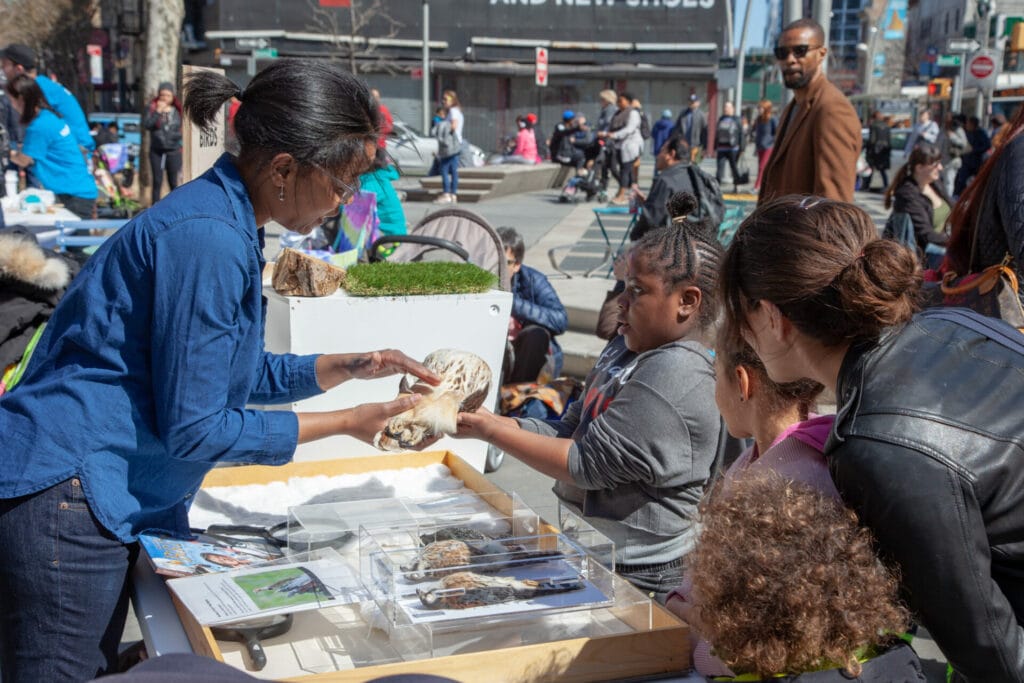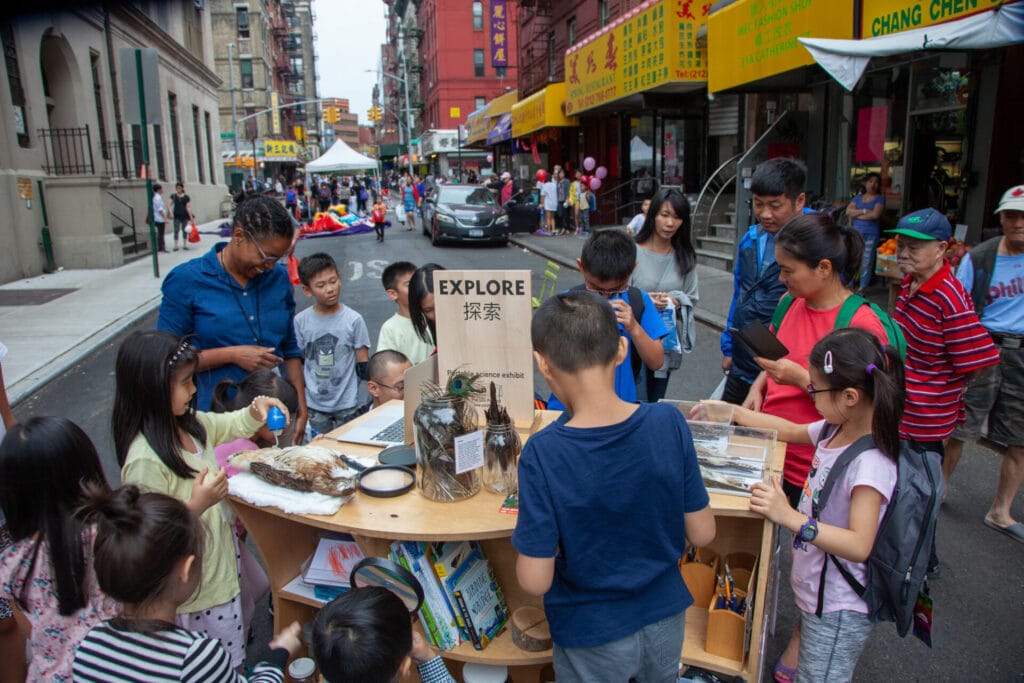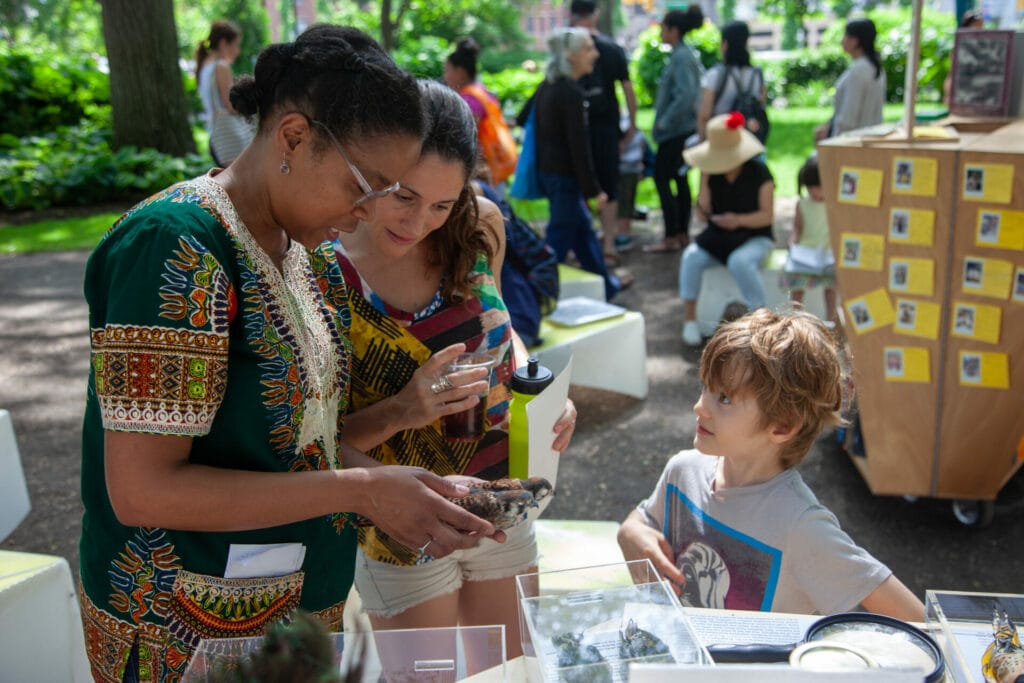Bird education becomes a bird podcast
By Georgia Silvera Seamans
Five years ago, I partnered with Street Lab to design a nature education project called Explore Birds, in which we presented pop-up exhibits of taxidermied birds in historically underserved New York City neighborhoods such as Chinatown.
A program of Washington Square Park Eco Projects, Explore Birds aims to showcase New York’s urban bird diversity using study skins, bio-facts, and other materials. The visitors to our science stations ranged in age and ethno-racial identity. I am a chronic jotter and so always carry a notebook with me. I took quick notes of most of the interactions with participants during one of our Chinatown pop-ups.

“Are they real?” [Many people asked this question.]
Of the red-tailed hawk, a teenager asked, “Is it a falcon? I used to see many in this area but not anymore.”
“This is so cool. I love pigeons.”
“Are they dead?”
“What would happen if a real bird came by?”
“Which has the sharpest beak?”
“Where I play (in New Jersey), there is a hawk that perches and watch us. It shows the environment is better.”
“Would you find these birds in New York?”
Of the red-tailed hawk, “Is it an owl?”
“That’s disgusting!” exclaimed a young girl.
“Are they real? I’m not touching them!” shouted a teen girl.
“Birds are cool,” said a boy.
“Is that a raptor bird?” asked a young girl about the American Kestrel. “I’m guessing that’s another raptor,” as she pointed to the Red-tailed Hawk. I asked her if she studies birds in school. “I love birds a lot,” she said. “I love falcons.”
“I chase it [a pigeon] away every day from [pooping] on my car.”
“Are the birds for sale?” an older man asked in Cantonese.
Of the Tufted Titmouse, a boy asked, “Are these baby birds?”
“I thought they were sleeping.”

The curiosity displayed in these questions, statements, and short stories are not unique to New York’s Chinatown. I have installed Explore Birds in other parts of the city, ranging from uptown Manhattan to Brooklyn, Queens, and 2,772-acre Pelham Park in the Bronx. In every location, I’ve been the fortunate recipient of New Yorkers’ bird stories. At some point, taking quick notes on people’s observations and experiences no longer seemed enough. I wanted to record their stories in their own voices and share their words with other New Yorkers, to bolster those who love the city’s wildlife and change the minds of those who are skeptical that urban nature exists.
I reached out to the producer of a popular bird podcast for help. We talked on the phone and he generously provided basic equipment (a digital recorder), a copy of Out on the Wire by Jessica Abel, and tips and tricks of the trade. I began to record stories at our pop-ups in spring 2019. The COVID-19 pandemic halted in-person recording in 2020, but we pivoted. While missing the spontaneous encounters, we were able to use our social and professional to recruit participants for Season 1. We spoke with a variety of people via Zoom about their interactions with wild birds in cities and suburbs.
Thus was born the Your Bird Story podcast — launched in September 2020, with a new episode released on the second Thursday of each month.
The “we” behind Your Bird Story consists of me and Loyan Beausoleil, an artist, early childhood educator, avian conservation scientist, and Bird Program Manager at Eco Projects. Our producer is Pod to the People.
The podcast has an unusual focus: We don’t interview professional or institutionally-affiliated bird watchers. We’re not explicitly focused on ornithology or bird science, though interviewees drop science into our conversations. We don’t privilege academic expertise over lived, local knowledge of birds. Also, we don’t limit the voices to adults. The final episode of Season 1 is titled “Bird Girls” and shares the ways in which young girls are observing and engaging with birds. (A shout-out to my colleague Loyan for this brilliant idea!)

The title of each episode indicates the topic of conversation. The first episode (Tanager) is our most popular one, followed by Episode 2 (Cardinal), then Episode 4 (In the Field). The latter is a collection of three interviews I conducted in a mix of parks and streets before the pandemic. My first love is trees, so Episode 6 with Dr. Thomas Easley, forester and Diversity-Equity-Inclusion specialist, is significant to me.
We’ve received votes of confidence from listeners. For example, one listener to Episode 5 (Raptor) told us, “I just listened to Shawn’s Bird Story, and it was fantastic…a great interviewer…. Anyhow, Your Bird Story is a super project.”
We released ten episodes in our initial year. With funding from The Puffin Foundation, we will spend the summer and fall of 2021 producing Season Two.
Give a listen to our past episodes! Even better, if you’re relatively new to the birding scene, we’d love to hear your story. Reach out to us at hello@wspecoprojects.org.
Georgia Silvera Seamans is a street-tree forester. She directs Washington Square Park Eco Projects and is one of the organizers of #BlackBotanistsWeek. Georgia’s articles have appeared in Urban Forestry & Urban Greening, Arboriculture & Urban Forestry, Popular Science, and Audubon magazine.
